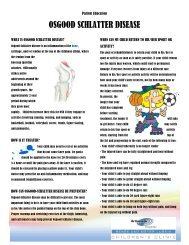“It's A Bargain” Thrift Shop - Orthopaedic Hospital
“It's A Bargain” Thrift Shop - Orthopaedic Hospital
“It's A Bargain” Thrift Shop - Orthopaedic Hospital
You also want an ePaper? Increase the reach of your titles
YUMPU automatically turns print PDFs into web optimized ePapers that Google loves.
20<br />
Most of the medicines that are available<br />
now decrease the number of bone-absorbing<br />
cells, thereby leading to an increase in bone<br />
mass that persists for two or three years. Very<br />
few agents actually stimulate the bone-forming<br />
cells. Obviously, what you want to be able to<br />
do is a yin and yang thing. You’d like to be able<br />
to increase bone formation and decrease bone<br />
absorption at the same time.<br />
motion: How would you treat a middle-aged person<br />
at risk of bone loss?<br />
Dr. Adams: I would measure bone-mineral density<br />
and check vitamin D and urine status. I’d<br />
look for an overactive thyroid. I would check<br />
parathyroid hormone levels to screen for a<br />
common disease called primary hyperparathyroidism,<br />
which is caused by overproduction of<br />
parathyroid hormone, which in turn increases<br />
osteoclastic bone absorption.<br />
Then, I would check to make sure that steroid<br />
production was normal. In a man, I’d measure<br />
androgens — testosterone. In a woman,<br />
I’d measure pituitary hormones that would tell<br />
me whether her ovaries were making enough<br />
estrogen or not.<br />
Simply by analyzing these findings and<br />
optimizing the therapy, I can make a person<br />
very susceptible to the drugs that are available<br />
now.<br />
motion: An ounce of prevention is worth a pound<br />
of cure, as Ben Franklin would say.<br />
Dr. Adams: Yes. The lesson here is that most of<br />
the diseases we deal with are pediatric diseases.<br />
They actually are present starting in children.<br />
If we could divert our attention to looking for<br />
those diseases in children, we could certainly<br />
save a lot of suffering. If we could prevent fractures,<br />
it would make a big difference.<br />
Consider Pope John XXIII. He died of a hip<br />
fracture. When you’re bent over with fractures<br />
of the spine, all your body weight is thrust<br />
forward. He was walking up a set of stairs and<br />
slipped. He hit his hip and cracked the bone.<br />
He then caught pneumonia, developed a pulmonary<br />
embolism and died.<br />
The idea is to do something before people<br />
research<br />
get to that stage. We’re trying to put together a<br />
team of scientists that can look at all aspects of<br />
the disease and cull out an area that is likely to<br />
be most successful for intervention and focus<br />
our activities there.<br />
motion: Apart from osteoporosis, what would be<br />
another key project here?<br />
Dr. Adams: Another example we’re working on<br />
relates to inflammation caused by prostheses.<br />
Suppose someone breaks a hip or has arthritis.<br />
You have to repair the hip by putting in a prosthesis.<br />
There’s a part that goes on the pelvis,<br />
which is the socket, and then you have the ball,<br />
which fits in the back and is part of the femur.<br />
“The lesson here is that most of the diseases<br />
we deal with are pediatric diseases. They<br />
actually are present starting in children. If<br />
we could divert our attention to looking for<br />
those diseases in children, we could certainly<br />
save a lot of suffering. If we could prevent<br />
fractures, it would make a big difference.”<br />
To put both of these things in, you have to use<br />
materials that are not inflammatory.<br />
Can you imagine if you put in something<br />
that causes inflammation? It would compound<br />
the problem because you’ve just redeveloped<br />
arthritis at a very rapid rate.<br />
So, if you have a foreign material sitting in<br />
that joint, it elicits the body’s own immune cells<br />
to get rid of that foreign material. That’s what<br />
causes the destructive arthritis we see in people<br />
who have had implants for a long time.<br />
One major reason why implants turn out to<br />
be inflammatory is because some of the plastics<br />
— used either on the head of the femur or on<br />
the socket, or both — actually shed particles.<br />
These particles stimulate the immune response<br />
as if they were bacteria or foreign invaders.<br />
It’s a lot harder for a living cell to get rid of a<br />
piece of plastic than bacteria, which it can actually<br />
attack, degrade and kill. A piece of plastic<br />
doesn’t go anyplace. It sits in there and continu-



